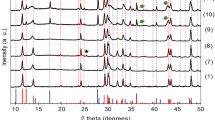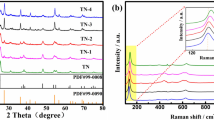Abstract
Na2Ti6O13 (NTO) and K2Ti6O13 (KTO) catalysts were prepared by the sol–gel method by adjusting the pH during hydrolysis. Both the prepared catalysts exhibited a rod-like morphology, demonstrating some microstructural changes such as changes in their rod length, surface area, pore volume, and crystallinity as a result of the pH conditions during synthesis. It is assumed that these changes and the presence of impurities (TiO2) were responsible for the different behaviors observed in the CO2 photocatalytic reduction to formaldehyde and methanol under UV irradiation without any cocatalyst. For example, the NTO sample synthesized without catalyst (neutral media; N-NTO) showed the highest formaldehyde production (93 μmol g−1), which may be due to the presence of TiO2 in both the anatase and rutile phases (up to 10 w%). On the contrary, the neutral synthesized KTO sample (N-KTO), a purer catalyst than NTO (anatase concentration below 5 w%), enhanced methanol production (95 μmol g−1) because of its more favorable physicochemical properties and band position.

Highlights
-
Na2Ti6O13 and K2Ti6O13 catalysts were prepared by the sol–gel method by adjusting the pH during hydrolysis.
-
The CO2 photocatalytic reduction to formaldehyde and methanol was carried out by using both catalysts.
-
The presence of TiO2 as an impurity in samples modifies the photocatalytic reaction yields.
-
Higher formaldehyde production was obtained using the neutral NTO sample (93 μmol g−1).
-
Methanol production was achieved only using the KTO catalysts (95 μmol g−1; KTO-N-SG).









Similar content being viewed by others
References
Kočí K, Obalová L et al. (2009) Effect of TiO2 particle size on the photocatalytic reduction of CO2. Appl Catal B Environ 89:494–502. https://doi.org/10.1016/J.APCATB.2009.01.010
Mizuno T, Adachi K et al. (1996) Effect of CO2 pressure on photocatalytic reduction of CO2 using TiO2 in aqueous solutions. J Photochem Photobiol A Chem 98:87–90. https://doi.org/10.1016/1010-6030(96)04334-1
Shehzad N, Tahir MK et al. (2018) A critical review on TiO2 based photocatalytic CO2 reduction system: strategies to improve efficiency. J CO2 Util 26:98–122. https://doi.org/10.1016/j.jcou.2018.04.026
Sayama K, Arakawa H (1993) Photocatalytic decomposition of water and photocatalytic reduction of carbon dioxide over zirconia catalyst. J Phys Chem 97:531–533. https://doi.org/10.1021/j100105a001
Shan J, Raziq F et al. (2017) Improved charge separation and surface activation via boron-doped layered polyhedron SrTiO3 for co-catalyst free photocatalytic CO2 conversion. Appl Catal B Environ 219:10–17. https://doi.org/10.1016/J.APCATB.2017.07.024
Bi Y, Ehsan MF et al. (2015) Synthesis of Cr-doped SrTiO3 photocatalyst and its application in visible-light-driven transformation of CO2 into CH4. J CO2 Util 12:43–48. https://doi.org/10.1016/J.JCOU.2015.10.004
Nakanishi H, Iizuka K (2017) Highly active NaTaO3-based photocatalysts for CO2 reduction to form CO using water as the electron donor. ChemSusChem 10:112–118. https://doi.org/10.1002/cssc.201601360
Li M, Li P et al. (2015) Highly efficient and stable photocatalytic reduction of CO2 to CH4 over Ru loaded NaTaO3. Chem Commun 51:7645–7648. https://doi.org/10.1039/C5CC01124H
Jeyalakshmi V, Mahalakshmy R et al. (2016) Photocatalytic reduction of carbon dioxide in alkaline medium on La modified sodium tantalate with different co-catalysts under UV–Visible radiation. Catal Today 266:160–167. https://doi.org/10.1016/J.CATTOD.2015.09.004
Tsuneoka H, Teramura K et al. (2010) Adsorbed species of CO2 and H2 on Ga2O3 for the photocatalytic reduction of CO2. J Phys Chem C 114:8892–8898. https://doi.org/10.1021/jp910835k
Yamamoto M, Yoshida T et al. (2015) Photocatalytic reduction of CO2 with water promoted by Ag clusters in Ag/Ga2O3 photocatalysts. J Mater Chem A 3:16810–16816. https://doi.org/10.1039/C5TA04815J
Andersson S, Wadsley AD (1962) The structures of Na2Ti6O13 and Rb2Ti6O13 and the alkali metal titanates. Acta Cryst 15:194–201. https://doi.org/10.1107/S0365110X62000511
Cid-Dresdner H, Buerger MJ (1962) The crystal structure of potassium hexatitanate K2Ti6O13. Z für Kristallogr Cryst Mater 117:1–6. https://doi.org/10.1524/zkri.1962.117.16.411
Wang X, Li Z et al. (2014) One-dimensional titanium dioxide nanomaterials: nanowires, nanorods, and nanobelts. Chem Rev 114:9346–9384. https://doi.org/10.1021/cr400633s
Reddy NL, Kumar DP et al. (2016) Co-catalyst free titanate nanorods for improved hydrogen production under solar light irradiation. J Chem Sci 128:649–656. https://doi.org/10.1007/s12039-016-1061-9
Xu C-Y, Wu J et al. (2013) Molten salt synthesis of Na2Ti3O7 and Na2Ti6O13 one-dimensional nanostructures and their photocatalytic and humidity sensing properties. CrystEngComm 15:3448–3454. https://doi.org/10.1039/c3ce27092k
Zhu X, Anzai A et al. (2019) Silver-loaded sodium titanate photocatalysts for selective reduction of carbon dioxide to carbon monoxide with water. Appl Catal B Environ 243:47–56. https://doi.org/10.1016/J.APCATB.2018.10.021
Yoshida H, Sato M et al. (2018) Sodium hexatitanate photocatalysts prepared by a flux method for reduction of carbon dioxide with water. Catal Today 303:296–304. https://doi.org/10.1016/J.CATTOD.2017.09.029
Torres-Martínez LM, Juárez-Ramírez I et al. (2008) Rietveld refinement of sol–gel Na2Ti6O13 and its photocatalytic performance on the degradation of methylene blue. J Sol–Gel Sci Technol 47:158–164. https://doi.org/10.1007/s10971-008-1790-4
Inoue Y, Kubokawa T et al. (1990) Photocatalytic activity of sodium hexatitanate, Na2Ti6O13, with a tunnel structure for decomposition of water. J Chem Soc 1990:1298–1299. https://doi.org/10.1039/C39900001298
Guan G, Kida T et al. (2003) Photoreduction of carbon dioxide with water over K2Ti6O13 photocatalyst combined with Cu/ZnO catalyst under concentrated sunlight. Appl Catal A Gen 249:11–18. https://doi.org/10.1016/S0926-860X(03)00205-9
Garay-Rodríguez LF, Torres-Martínez LM et al. (2019) Photocatalytic performance of K2Ti6O13 whiskers to H2 evolution and CO2 photo-reduction. J Energy Chem 37:18–28. https://doi.org/10.1016/J.JECHEM.2018.11.014
Escobedo Bretado MA, González Lozano MA et al. (2019) Synthesis, characterization and photocatalytic evaluation of potassium hexatitanate (K2Ti6O13) fibers. Int J Hydrog Energy 44:12470–12476. https://doi.org/10.1016/J.IJHYDENE.2018.06.085
Wang Q, Guo Q et al. (2015) Low temperature synthesis and characterization of substitutional Na-modified K2Ti6O13 nanobelts with improved photocatalytic activity under UV irradiation. RSC Adv 5:66086–66095. https://doi.org/10.1039/c5ra10640k
Khan A, Alam U et al. (2018) Surface modification of Na-K2Ti6O13 photocatalyst with Cu(II)-nanocluster for efficient visible-light-driven photocatalytic activity. Mater Lett 220:50–53. https://doi.org/10.1016/J.MATLET.2018.02.132
Yu J, Yu JC et al. (2003) Effects of acidic and basic hydrolysis catalysts on the photocatalytic activity and microstructures of bimodal mesoporous titania. J Catal 217:69–78. https://doi.org/10.1016/S0021-9517(03)00034-4
Behnajady MA, Eskandarloo H et al. (2011) Investigation of the effect of sol–gel synthesis variables on structural and photocatalytic properties of TiO2 nanoparticles. Desalination 278:10–17. https://doi.org/10.1016/j.desal.2011.04.019
Puangpetch T, Sreethawong T et al. (2008) Synthesis and photocatalytic activity in methyl orange degradation of mesoporous-assembled SrTiO3 nanocrystals prepared by sol–gel method with the aid of structure-directing surfactant. J Mol Catal A Chem 287:70–79. https://doi.org/10.1016/j.molcata.2008.02.027
Hafizah N, Sopyan I (2009) Nanosized TiO2 photocatalyst powder via sol–gel method: effect of hdrolysis degree on powder properties. Int J Photoenergy 2009:8. https://doi.org/10.1155/2009/962783
Siddiqui MA, Chandel VS, Azam A (2012) Comparative study of potassium hexatitanate (K2Ti6O13) whiskers prepared by sol–gel and solid state reaction routes. Appl Surf Sci 258:7354–7358. https://doi.org/10.1016/J.APSUSC.2012.04.018
Kang S-O, Jang H-S et al. (2007) Study of the growth of potassium titanate nanostructures prepared by sol–gel calcination process. Mater Lett 61:473–477. https://doi.org/10.1016/J.MATLET.2006.04.091
Baliteau S, Sauvet A-L (2007) Controlled synthesis and characterization of sodium titanate composites Na2Ti3O7/Na2Ti6O13. Solid State Ion 178:1517–1522. https://doi.org/10.1016/j.ssi.2007.09.002
Jung KT, Shul YG (1996) Synthesis of high surface area potassium hexatitanate powders by sol–gel method. J Sol–Gel Sci Technol 6:227. https://doi.org/10.1007/BF00402693
Quian QH, Zhou XF, Hu YY et al. (2007) Preparation of smooth potassium hexatitanate nanofilms by sol–gel method. J Mater Sci 42:8222. https://doi.org/10.1007/s10853-007-1695-6
Torres-Martínez LM, Cruz-López A et al. (2008) Synthesis of sol–gel Na2ZrxTi6-6O13 (0 ≤ x ≤ 1) materials and their performance in photocatalytic degradation of organic dyes. Res Chem Intermed 34:403–416. https://doi.org/10.1163/156856708784040678
Sauvet A-L, Baliteau S et al. (2004) Synthesis and characterization of sodium titanates Na2Ti3O7 and Na2Ti6O13. J Solid State Chem 177:4508–4515. https://doi.org/10.1016/j.jssc.2004.09.008
Torres-Martínez LM, Sánchez-Trinidad C (2010) Synthesis, characterization, and 2,4-dichlorophenoxyacetic acid degradation on In-Na2Ti6O13 sol–gel photocatlysts. Res Chem Intermed 36:5–15. https://doi.org/10.1007/s11164-010-0109-6
Garay-Rodríguez LF, Torres-Martínez LM et al. (2018) Photocatalytic evaluation of composites of Ba3Li2Ti8O20-CuO in the reduction of CO2 to formaldehyde under visible light irradiation. J Photochem Photobiol A Chem 361:25–33. https://doi.org/10.1016/J.JPHOTOCHEM.2018.05.003
Hernandez A, Torres-Martínez LM et al. (2002) Synthesis of Ba3Li2Ti8O20 sol–gel at basic conditions. Mater Lett 54:62–69. https://doi.org/10.1016/S0167-577X(01)00540-7
Gigante AC, Gotardo MA et al. (2004) Spectrophotometric determination of formaldehyde with chromotropic acid in phosphoric acid medium assisted by microwave oven. Microchem J 77:47–51. https://doi.org/10.1016/j.microc.2003.12.002
Zhan Y-Y, Zang Y et al. (2010) A novel visible spectrophotometric method for the determination of methanol using sodium nitroprusside as spectroscopic probe. J Chin Chem Soc 57:230–235. https://doi.org/10.1002/jccs.201000035
Sehati S, Entezari MH (2016) Ultrasonics Sonochemistry Ultrasound facilitates the synthesis of potassium hexatitanate and co-intercalation with PbS–CdS nanoparticles. Ultrason Sonochem 32:348–356. https://doi.org/10.1016/j.ultsonch.2016.04.003
Wenk HR, Matthies L et al. (1994) Mat Sci Forum 157–162:473–480
Ferrari M, Lutterotti L et al. (1994) Method for the simultaneous determination of anisotropic residual stresses and texture by X-ray diffraction. J Appl Phys 76:7246–7255. https://doi.org/10.1063/1.358006
Zhao J, Zhao J et al. (2014) Rietveld refinement of hydroxyapatite, tricalcium phosphate and biphasic materials prepared by solution combustión method. Ceram Int 40:3379–3388. https://doi.org/10.1016/J.CERAMINT.2013.09.094
Ramírez JR, Palomares-Sánchez S et al. (2006) Rietveld refinement of amorphous SiO2 prepared via sol–gel method. Mater Lett 60:3526–3529. https://doi.org/10.1016/J.MATLET.2006.03.044
Manik SK, Pradhan SK (2006) Preparation of nanocrystalline microwave dielectric Zn2TiO4 and ZnTiO3 mixture and X-ray microstructure characterization by Rietveld method. Phys E Low Dimens Syst Nanostruct 33:69–76. https://doi.org/10.1016/j.physe.2005.11.019
Dutta H, Sahu P et al. (2003) Microstructure characterization of polymorphic transformed ball-milled anatase TiO2 by Rietveld method. Mater Chem Phys 77:153–164
Jaramillo J, Garzón BA et al. (2016) Influence of the pH of the synthesis using sol–gel method on the structural and optical properties of TiO2. J Phys Conf Ser 687:012099. https://doi.org/10.1088/1742-6596/687/1/012099
Tsega M, Dejene FB (2017) Influence of acidic pH on the formulation of TiO2 nanocrystalline powders with enhanced photoluminescence property. Heliyon 3:e00246. https://doi.org/10.1016/J.HELIYON.2017.E00246
Wang Q, Zhang B et al. (2018) Multifunctional 3D K2Ti6O13 nanobelt-built architectures towards wastewater remediation: selective adsorption, photodegradation, mechanism insight and photoelectrochemical investigation. Catal Sci Technol 8:6180–6195. https://doi.org/10.1039/c8cy01684d
Danks AE, Hall SR et al. (2016) The evolution of ‘sol–gel’ chemistry as a technique for materials synthesis. Mater Horiz 3:91–112. https://doi.org/10.1039/C5MH00260E
Brinker CJ, Scherer GW (1990) Aging of Gels. Sol–Gel Sci 356–405. https://doi.org/10.1016/B978-0-08-057103-4.50011-8
Thommes M, Kaneko K et al. (2015) Physisorption of gases, with special reference to the evaluation of surface area and pore size distribution (IUPAC Technical Report). Pure Appl Chem 87:1051–1069. https://doi.org/10.1515/pac-2014-1117
Manfroi DC, Dos Anjos A et al. (2014) Titanate nanotubes produced from microwave-assisted hydrothermal synthesis: photocatalytic and structural properties. Ceram Int 40:14483–14491. https://doi.org/10.1016/J.CERAMINT.2014.07.007
Yoshida H, Takeuchi M (2014) Potassium hexatitanate photocatalysts prepared by a flux method for water splitting. Catal Today 232:158–164. https://doi.org/10.1016/j.cattod.2013.10.046
Butler MA, Ginley DS et al. (1978) Prediction of flatband potentials at semiconductor−electrolyte interfaces from atomic electronegativities. J Electrochem Soc 125:228–232. https://doi.org/10.1149/1.2131419
Pearson RG (1988) Absolute electronegativity and hardness: application to inorganic chemistry. Inorg Chem 27:734–740. https://doi.org/10.1021/ic00277a030
Acknowledgements
This study was supported to CONACYT (Consejo Nacional de Ciencia y Tecnología, Mexico) through CB-2014-237049, PDCPN-2015-487, CONACYT-FC-1725 grants, the UANL (Universidad Autónoma de Nuevo León, Mexico) through PAIFIC-UANL2018-5 and SEP-PROFIDES 511-6/18-11852. Garay-Rodríguez thanks to CONACYT for his Ph.D. scholarship 635249.
Author information
Authors and Affiliations
Corresponding author
Ethics declarations
Conflict of interest
The authors declare that they have no conflict of interest.
Additional information
Publisher’s note Springer Nature remains neutral with regard to jurisdictional claims in published maps and institutional affiliations.
Rights and permissions
About this article
Cite this article
Garay-Rodríguez, L.F., Torres-Martínez, L.M. Photocatalytic CO2 reduction over A2Ti6O13 (A=Na and K) titanates synthesized by different pH-catalyzed sol–gel. J Sol-Gel Sci Technol 93, 428–437 (2020). https://doi.org/10.1007/s10971-019-05138-5
Received:
Accepted:
Published:
Issue Date:
DOI: https://doi.org/10.1007/s10971-019-05138-5




